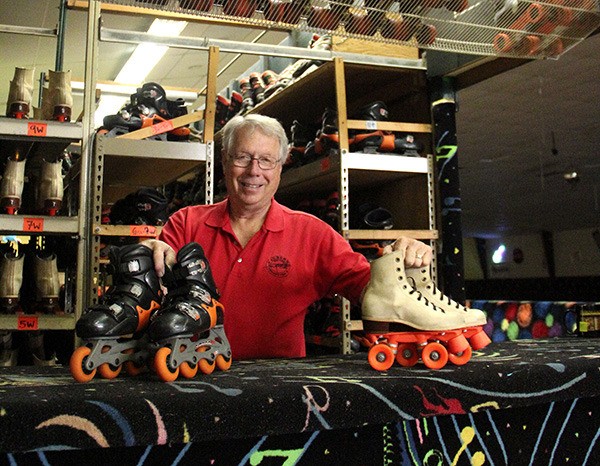If the walls of Auburn’s Skate Connection could only talk, oh, the stories they could share.
Tales of skaters young and old.
Tales of figure skating, speed skating and indoor hockey on roller skates.
Tales of Olympic speed skating gold medalist Apolo Ohno, who got his start on the maple wood floor of the Skate Connection.
Tales of the heyday of indoor skating during the disco-mad early 1980s.
Luckily, the walls don’t have to talk — they’ve got John Gustafson.
In September of 1973, Gustafson, then 29, bought the Skate Connection from its original owner, Jack Watkins.
“He used to own this whole block right here,” said Gustafson, now 69. “He inherited it from his mom. It used to be a farm, then he built the rink and the bowling lanes that were next door. He and his wife used to run them, but they’ve since passed.”
A skating rink was a perfect purchase for Gustafson, who said he still remembers the first time he laced on a pair of skates at the tender age of five.
“I’ve always had a burning desire to skate,” he said.
Throughout his youth and into adulthood, Gustafson competed in all forms of skating, going professional in speed and figure skating, even competing in roller skate hockey.
After graduating from the University of Oregon, Gustafson moved to the Puget Sound region in 1969 to work with Tiffany’s Skate Inn.
“I had an opportunity to come on board with a growing company at that time,” he said. “I opened and managed the one in Puyallup, which is still open.”
After trying without success to buy into the company, which at the time also operated a rink in Kent, Gustafson said he jumped at the chance to buy the Auburn Skate Connection, warts and all.
“The floor that was in it was an absolute embarrassment,” he said. “It was parquet tile. We dealt with that until 1978, and then I put down a particle board floor. I put down what they called roller board. It was 4 by 8-feet sheets, and they weighed 155 pounds each.”
In 1990, Gustafson added the current maple floor.
“I bid for it out in Lincoln, Nebraska in 1989,” Gustafson said. “The city was selling the floor and buying a new floor, so they put this one up for bid, and I won. And they said ‘you have to come out and get it, now.’ I knew the Special Olympics needed a portable floor up in Special Olympics, so I contacted them.”
Gustafson said the organizers agreed to come pick up the floor, store and then use it for the 1990 summer Special Olympics, before returning it to Gustafson to move and install in Auburn.
“So they came and picked it up and moved it up to the University of Minnesota,” Gustafson said. “At their cost, they picked it up and stored it. Then they put it up for the special Olympics. Then I was supposed to ship it up here at my cost, but the Target Corporation picked up the tab and drove it right out here. It took two tractor trailers.”
In his 40 years at the rink, Gustafson said, he’s seen the ebb and flow in skating’s popularity.
“There is always a seven-year cycle,” Gustafson said. “During the disco-era, in the 1980s, we just had to open the doors and we were packed. It was really the ‘in’ thing to do then.”
In the 1990s, Gustafson said, inline skates sparked a renewed interest in skating.
Inline skating came around in 1990 and became commonplace.
“That company was responsible for that. Before that it was just quads,” Gustafson said.
Although quads remain popular for activities that require more control, such as figure skating and roller derby, the increased speeds possible on inlines were part of the appeal, he said.
“You can just do more tricks on quads,” Gustafson said, “but the inlines are so much faster.”
The popularity gave rise to a new generation of speed skaters, including Olympian Ohno, whom Gustafson coached for three years.
“He was here for three years, then moved to Federal Way (Pattinsons West) for five years, then switched to ice,” Gustafson said. “He’s just a wonderful guy, a real nice guy.”
Gustafson said today’s skating business is in the middle of a popularity peak, thanks, in part, to the resurgence of roller derby.
“Derby has been a benefit to the popularity of skating,” Gustafson said. “The Dockyard Derby Dames practice here on Wednesdays and Sundays.”
The rink even hosted a youth derby camp during the summer.
The real key to weathering the ups and downs that come with any business, however, has been Gustafson’s emphasis on providing a family-friendly environment at the rink.
“We cater to families,” Gustafson said. “We try and make sure everything is clean and neat, and that everybody who comes in can have a good time. It’s good, wholesome recreation, where the whole family can come in and and enjoy some time together. I’ve got grandkids of the original skaters who used to come in coming in now. It’s just wonderful to see them coming in.”
To thank Auburn residents for their support the past 40 years, Skate Connection will host an anniversary open skate on Saturday and Sunday, with free admission and $1.50 skate rental.
“I just want to thank the people of Auburn for their continued support of the skating rink here,” he said. “They’ve been very supportive.”



